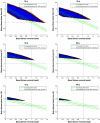Coordinated basal-bolus infusion for tighter postprandial glucose control in insulin pump therapy
- PMID: 20046653
- PMCID: PMC2769848
- DOI: 10.1177/193229680900300110
Coordinated basal-bolus infusion for tighter postprandial glucose control in insulin pump therapy
Abstract
Background: Basal and bolus insulin determination in intensive insulin therapy for type 1 diabetes mellitus (T1DM) are currently considered independently of each other. A new strategy that coordinates basal and bolus insulin infusion to cope with postprandial glycemia in pump therapy is proposed. Superior performance of this new strategy is demonstrated through a formal analysis of attainable performances in an in silico study.
Methods: The set inversion via interval analysis algorithm has been applied to obtain the feasible set of basal and bolus doses that, for a given meal, mathematically guarantee a postprandial response fulfilling the International Diabetes Federation (IDF) guidelines (i.e., no hypoglycemia and 2 h postprandial glucose below 140 mg/dl). Hypoglycemia has been defined as a glucose value below 70 mg/dl. A 5 h time horizon has been considered for a 70 kg in silico T1DM subject consuming meals in the range of 30 to 80 g of carbohydrates.
Results: The computed feasible sets demonstrate that current separated basal/bolus strategy dramatically limits the attainable performance. For a nominal basal of 0.8 IU/h leading to a basal glucose of approximately 100 mg/dl, IDF guidelines cannot be fulfilled for meals greater than 50 g of carbohydrates, independent of the bolus insulin computed. However, coordinating the basal and bolus insulin delivery can achieve this. A decrement of basal insulin during the postprandial period is required together with an increase in bolus insulin, in appropriate percentages, which is meal dependent. After 3 h, basal insulin can be restored to its nominal value.
Conclusions: The new strategy meets IDF guidelines in a typical day, contrary to the standard basal/bolus strategy, yielding a mean 2 h postprandial glucose reduction of 36.4 mg/dl without late hypoglycemia. The application of interval analysis for the computation of feasible sets is demonstrated to be a powerful tool for the analysis of attainable performance in glucose control.
Keywords: glucose control; insulin pump therapy; interval analysis; set inversion; type 1 diabetes mellitus.
© Diabetes Technology Society
Figures








Similar articles
-
Combining basal-bolus insulin infusion for tight postprandial glucose control: an in silico evaluation in adults, children, and adolescents.J Diabetes Sci Technol. 2010 Nov 1;4(6):1424-37. doi: 10.1177/193229681000400617. J Diabetes Sci Technol. 2010. PMID: 21129338 Free PMC article.
-
Optimal insulin pump dosing and postprandial glycemia following a pizza meal using the continuous glucose monitoring system.Diabetes Technol Ther. 2005 Apr;7(2):233-40. doi: 10.1089/dia.2005.7.233. Diabetes Technol Ther. 2005. PMID: 15857224 Clinical Trial.
-
Calculation of the best basal-bolus combination for postprandial glucose control in insulin pump therapy.IEEE Trans Biomed Eng. 2011 Feb;58(2):274-81. doi: 10.1109/TBME.2010.2058805. Epub 2010 Jul 15. IEEE Trans Biomed Eng. 2011. PMID: 20639170
-
Reassessment of insulin dosing guidelines in continuous subcutaneous insulin infusion treated type 1 diabetes.Curr Diab Rep. 2014 Jun;14(6):503. doi: 10.1007/s11892-014-0503-3. Curr Diab Rep. 2014. PMID: 24792068 Review.
-
Sliding scale insulin for non-critically ill hospitalised adults with diabetes mellitus.Cochrane Database Syst Rev. 2018 Nov 29;11(11):CD011296. doi: 10.1002/14651858.CD011296.pub2. Cochrane Database Syst Rev. 2018. PMID: 30488948 Free PMC article.
Cited by
-
Super Bolus-A Remedy for a High Glycemic Index Meal in Children with Type 1 Diabetes on Insulin Pump Therapy?-A Randomized, Double-Blind, Controlled Trial.Nutrients. 2024 Jan 16;16(2):263. doi: 10.3390/nu16020263. Nutrients. 2024. PMID: 38257156 Free PMC article. Clinical Trial.
-
Systems engineering medicine: engineering the inflammation response to infectious and traumatic challenges.J R Soc Interface. 2010 Jul 6;7(48):989-1013. doi: 10.1098/rsif.2009.0517. Epub 2010 Feb 10. J R Soc Interface. 2010. PMID: 20147315 Free PMC article. Review.
-
Bolus Advisors: Sources of Error, Targets for Improvement.J Diabetes Sci Technol. 2018 Jan;12(1):190-198. doi: 10.1177/1932296817718213. Epub 2017 Jul 25. J Diabetes Sci Technol. 2018. PMID: 28741369 Free PMC article. Review.
-
Probabilistic evolving meal detection and estimation of meal total glucose appearance.J Diabetes Sci Technol. 2009 Sep 1;3(5):1022-30. doi: 10.1177/193229680900300505. J Diabetes Sci Technol. 2009. PMID: 20144415 Free PMC article.
-
Multicenter closed-loop insulin delivery study points to challenges for keeping blood glucose in a safe range by a control algorithm in adults and adolescents with type 1 diabetes from various sites.Diabetes Technol Ther. 2014 Oct;16(10):613-22. doi: 10.1089/dia.2014.0066. Epub 2014 Jul 8. Diabetes Technol Ther. 2014. PMID: 25003311 Free PMC article.
References
-
- Chase HP, Saib SZ, Mackenzie T, Hansen MM, Garg SK. Post-prandial glucose excursions following four methods of bolus insulin administration in subjects with type 1 diabetes. Diabet Med. 2007;19(4):317–321. - PubMed
-
- Zisser H, Robinson L, Bevier W, Dassau E, Ellingsen C, Doyle FJ, III, Jovanovič L. Bolus calculator: a review of four “smart” insulin pumps. Diabetes Technol Ther. 2008;10(6):441–444. - PubMed
-
- Moore RE. Englewood Cliffs: Prentice-Hall; 1966. Interval analysis.
-
- Moore RE. SIAM; 1979. Methods and applications of interval analysis.
-
- Alefeld G, Herzberger J. New York: Academic Press; 1983. Introduction to interval computations.
Publication types
MeSH terms
Substances
LinkOut - more resources
Full Text Sources
Medical

